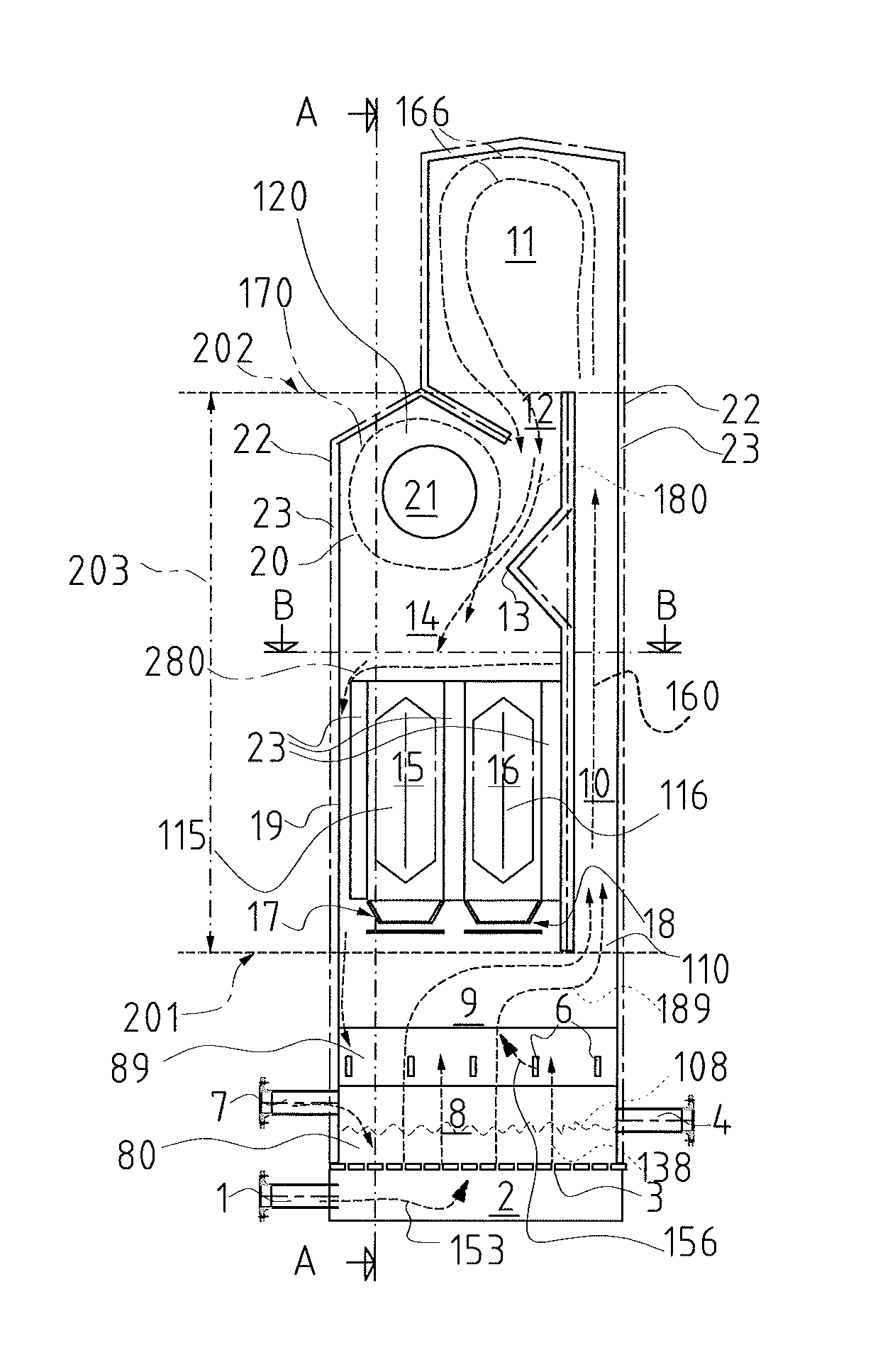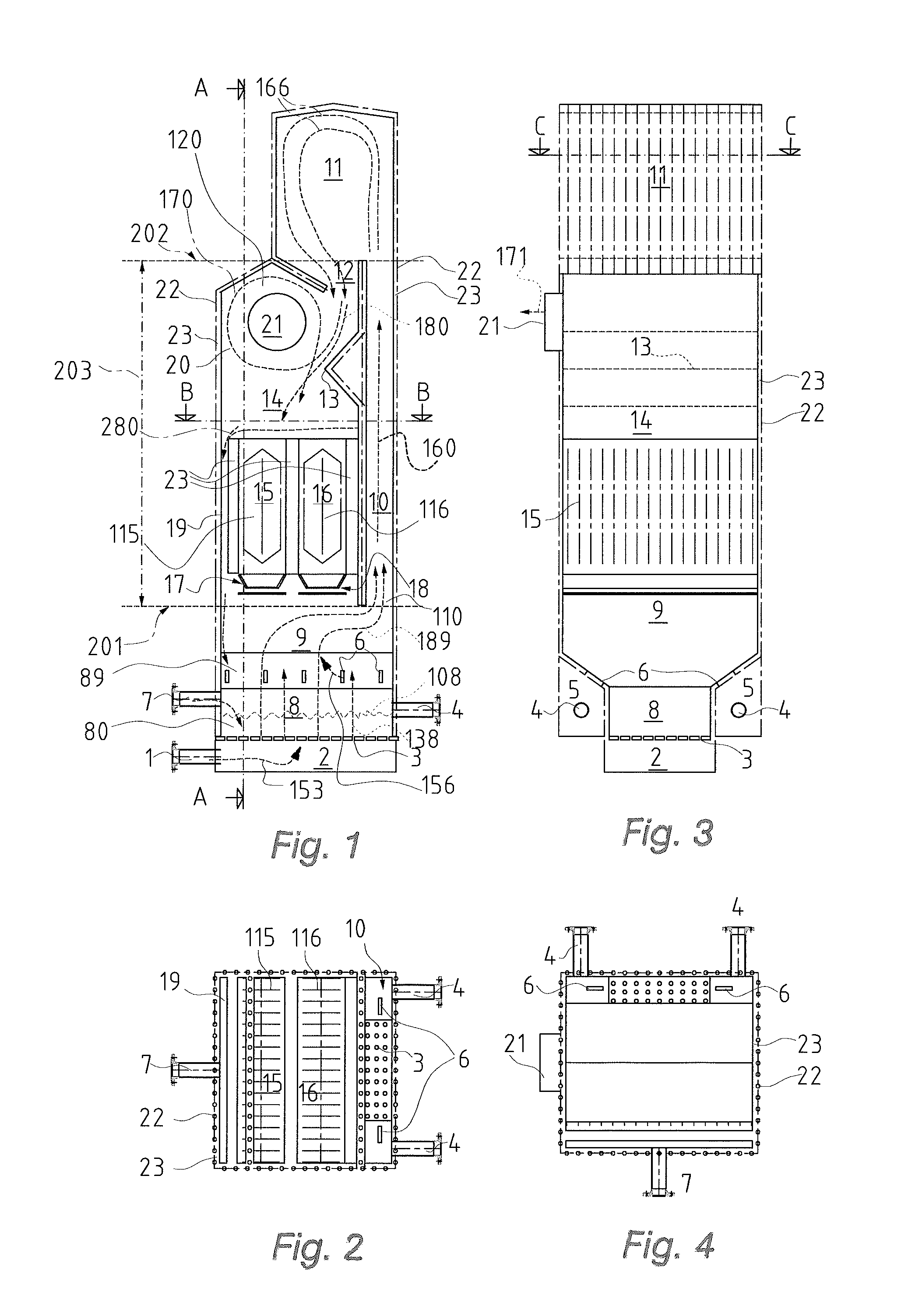Because of this, in fluidized-bed reactors, combustion air supplied from the walls mixes poorly with the low-
oxygen vertical main flow.
Since, at the same time, the controlling of the gas temperature requires a significant
volume fraction of fluidized material in the
reaction chamber as a whole, the requirements of good horizontal mixing and good
temperature control are mutually irreconcilably inconsistent in all fluidized-bed reactors.
The said inconsistency is in fact an unavoidable and fundamental problem of combustion reactors based on fluidized-bed technology.
The problem of poor horizontal mixing concerns especially the gas formed as a result of the thermal degradation of fuel in the
fluidized bed.
A functional
disadvantage of bubbling fluidized-bed reactors in particular is that especially with dusty, wet fuels which contain an abundance of vaporisable compounds, combustion shifts excessively to the area above the fluidized bed, where there is only a small amount of fluidized material preventing the temperature from rising.
As a result, the temperature in the upper part of the combustion chamber increases excessively and the temperature in the fluidized bed remains too low, which may result in ash burning in the upper part of the combustion chamber and / or the extinguishing of the combustion chamber.
In bubbling fluidized-bed reactors, problems with
temperature control are also faced if the fuel has a
coarse particle size and contains only a small amount of vaporisable compounds, in which case combustion takes place mainly in the fluidized bed.
An excessive rise in the temperature of the fluidized bed then becomes a problem.
For the foregoing reasons, in a combustion device based on an
bubbling fluidized bed can only be burned the type of fuels with which the said problems are controllable, which prevents or restricts the use of more economical fuels.
This means that already with part loads of 50%, the circulating mass flow falls to an insignificant level and the circulating mass reactor begins to function like bubbling fluidized-bed reactors, with the above-mentioned problems.
Since in circulating mass reactors a significant
volume fraction of fluidized material has to be allowed also in the upper part of the combustion chamber to balance temperature differences, the poor horizontal mixing of gas in the combustion chamber of the circulating mass reactor becomes a problem.
As in bubbling fluidized-bed reactors, the mixing problem is emphasized when burning fuels containing an abundance of fine fractions and / or vaporisable compounds.
Especially changes in
humidity, which are typical of biomasses, cause problems in both bubbling fluidized-bed boilers and circulating mass boilers.
Their further joint fundamental
disadvantage is that the cooling of the furnace takes place by means of
heat transfer surfaces, whereby the cooled wall surfaces of the combustion chamber, typically used for vaporising the circulation water, bring about an uncontrollable heat loss.
This increases the lowest permissible effective heat value of the fuel used significantly, which limits the range of fuels
usable in the boiler, that is, the flexibility of fuels.
Another joint fundamental
disadvantage of the said reactors is that in them, the
heat transfer surfaces, especially the
superheater, come into direct contact with the corrosive compounds of fuel ash.
To reduce the
corrosion of the superheaters, the temperature of the
superheated steam has to be limited, as a result of which the electric supply of the power
plant decreases.
Also in this respect biomasses, among others, are problematic.
The said disadvantages are particularly problematic when burning materials classified as waste.
A further problem involved in the direct cooling of the furnaces of CFB boilers is that a bad compromise has to be made between the height of the furnace and the conveyance of the fluidized material, and that the
power density (MW / m3) of the furnace remains low, which makes the furnace unnecessarily large and expensive.
As a result of the compromise, the furnace is rendered high and the required fluidized material circulation can only be maintained close to nominal output.
Another disadvantage of CFB boilers is that the external separator and return conduit fitted alongside the furnace increase the space requirement and price of the boiler significantly.
Solutions fitted in the return conduits of the circulating material have, in addition, been based on fluidized-bed technology which has brought on several problems, which are listed in the following.
Firstly, a fundamental problem of heat exchangers fitted in the return conduits of circulating material in circulating mass reactors is the insufficient circulating mass flow of fluidized material.
This problem is due to the unavoidable inconsistency in vertical combustion chambers between the
delay time required by combustion and the requirements set by the conveyance of circulating material.
The said problem becomes particularly overwhelming when the boiler has to be used on part load, that is, with partial
power output.
Secondly, even if the above-mentioned heat exchangers fitted in the return conduits could be made to operate satisfactorily close to the nominal output, they will not eliminate the limitation of the
heat transfer surfaces fitted in the furnace for the lowest permissible effective heat value of the fuel used in the boiler.
The cooling surfaces fitted in the combustion chamber unavoidably limit the flexibility of fuels of the boiler and are susceptible to soiling, wear and
corrosion.
Moreover, a fluidized-bed cooler as such is expensive and complex from an equipment-technical point of view and its
pipe system is subjected to extremely strong
erosion.
The adjustment of the circulating
material flow is also difficult to carry out in a functioning manner in them.
Furthermore, the internal consumption of the fluidized-bed cooler is high and the fluidizing gas required creates an additional heat requirement in the
heat exchanger.
An additional challenge is presented by the fact that the fluidizing gas in the heat exchangers fitted in the return conduits must be conducted away from the
heat exchanger in such a way that it will not essentially hinder the operation of the particle separator.
Even at best, the said solution can only provide partial improvement to the
temperature control of circulating mass reactors.
It does not, however, eliminate or diminish the other fundamental disadvantages of circulating mass reactors described above.
This would lead to numerous problems.
Secondly, the velocity of freely falling circulating mass would become high, which would cause rapid wear of the heat transfer surfaces.
The gas flow passing through the return conduit to the
cyclone would then increase to problematic proportions and the ash compounds carried along with the gas would cause corrosion of the heat transfer surfaces, especially of the
superheater.
Dividing the circulating mass sufficiently evenly over the cross-section of the cooler would not be possible in practice.
However, an even greater disadvantage of the solution disclosed in the publication U.S. Pat. No. 4,672,918 is that heat transfer surfaces are fitted in the reactor's furnace.
They unavoidably reduce the flexibility of fuels, especially with part loads.
The said solution does not solve in any way the above-mentioned fundamental and essential problems of combustion control.
Furthermore, the reactor according to the publication would result in an expensive construction requiring ample maintenance.
In a CTC reactor, combustion and the conveyance of the circulating material takes place in the same vertical combustion chamber, and thus in order to limit the height of the reactor, a bad compromise has to be made between a sufficient
delay time from the point of view of combustion and the gas velocity required by the conveyance of the circulating material.
The shifting of combustion into the
cyclone chamber would result in a detrimental increase in gas temperature, because there the
volume fraction of fluidized material is approximately zero.
The
thermal energy from postcombustion transferred to the
cyclone is also not available for maintaining the temperature in the reactor's combustion chamber.
This results in a limitation of the flexibility of fuels; especially the autogenous combustion of humid materials causing intensive postcombustion cannot be carried out in CTC reactors, even if the heat value of the material would allow it.
Postcombustion in the cyclone also increases the maintenance costs of the structures of the reactor and shortens their life.
This problem is worsened by the axial-
symmetric structure of the CTC reactor, due to which the
coke- and hydro-carbon-containing gas produced in the vicinity of the
fuel supply means as a result of the thermal degradation of fuel and the oxygenous gas distributed evenly over the entire
nozzle base mix poorly before the riser conduit.
Although in a CTC reactor, the heat transfer can be adjusted close to the nominal output and the soiling and corrosion problems of the superheaters have been solved, the above-mentioned disadvantage of a CTC reactor is that the furnace has to be designed as a compromise of the inconsistent requirements of the
combustion process and adiabatic cooling.
Single-step separation of
fluidization material can also be considered a disadvantage of CTC reactors, because the large volume fraction of the gas coming into the cyclone causes
erosion of the structures and increases the penetration of solids.
A problem with the structure of the CTC reactor is also the riser conduit, which is difficult to implement in cooled form, especially in small reactors, and which, when uncooled, especially when burning corrosive, ash-containing substances, increases the service and maintenance costs of the reactor.
Following the rise in the price of fossil fuels, it would be cost-effective for power plants to use the poor-quality fuels available, but this is not possible for the above reasons.
 Login to View More
Login to View More  Login to View More
Login to View More 

